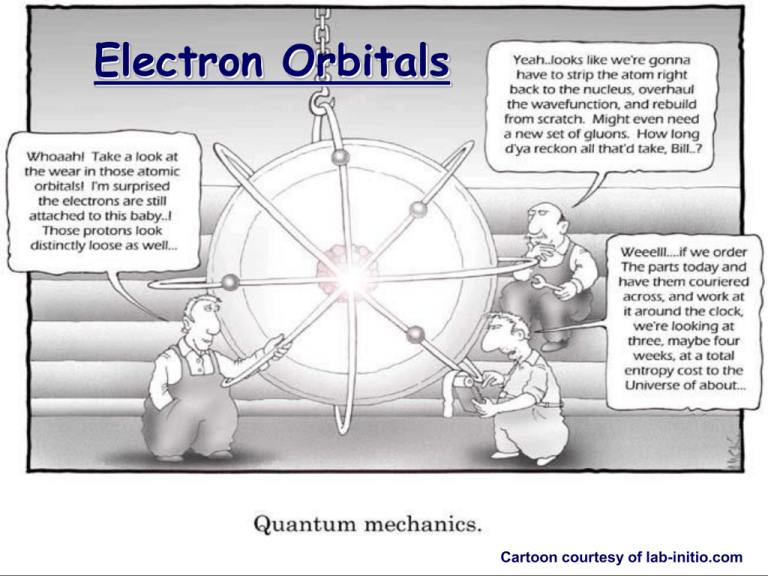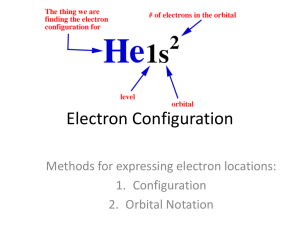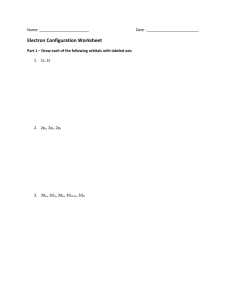Electrons - ScienceGeek.net
advertisement

Electron Orbitals Cartoon courtesy of lab-initio.com The Bohr Model of the Atom I pictured electrons orbiting the nucleus much like planets orbiting the sun. But I was wrong! They’re more like bees around a hive. Neils Bohr Quantum Mechanical Model of the Atom Mathematical laws can identify the regions outside of the nucleus where electrons are most likely to be found. These laws are beyond the scope of this class… Heisenberg Uncertainty Principle “One cannot simultaneously determine both the position and momentum of an electron.” You can find out where the electron is, but not where it is going. Werner Heisenberg OR… You can find out where the electron is going, but not where it is! Electron Energy Level (Shell) Generally symbolized by n, it denotes the probable distance of the electron from the nucleus. “n” is also known as the Principle Quantum number Number of electrons that can fit in a shell: 2n2 Electron Orbitals An orbital is a region within an energy level where there is a probability of finding an electron. Orbital shapes are defined as the surface that contains 90% of the total electron probability. s Orbital shape The s orbital has a spherical shape centered around the origin of the three axes in space. p orbital shape There are three dumbbell-shaped p orbitals in each energy level above n = 1, each assigned to its own axis (x, y and z) in space. d orbital shapes Things get a bit more complicated with the five d orbitals that are found in the d sublevels beginning with n = 3. To remember the shapes, think of “double dumbells” …and a “dumbell with a donut”! Shape of f orbitals Energy Levels, Orbitals, Electrons Energy Level (n) Orbital type in the energy level (types = n) Number of orbitals Number of Electrons Number of electrons per Energy level (2n2) 1 s 1 2 2 2 s p 1 3 2 6 8 3 s p d 1 3 5 2 6 10 18 4 s p d f 1 3 5 7 2 6 10 14 32 Orbital filling table Electron Spin Electron spin describes the behavior (direction of spin) of an electron within a magnetic field. Possibilities for electron spin: 1 2 1 2 Pauli Exclusion Principle Two electrons occupying the same orbital must have opposite spins Wolfgang Pauli Electron configuration of the elements of the first three series Element Lithium Configuration notation Orbital notation 1s22s1 [He]2s1 ____ 1s Beryllium ____ ____ 2p ____ ____ 2s ____ ____ 2p ____ [He]2s2p2 ____ 2s ____ ____ 2p ____ 1s22s22p3 [He]2s2p3 ____ 2s ____ ____ 2p ____ 1s22s22p4 [He]2s2p4 ____ 2s ____ ____ 2p ____ 1s22s22p5 [He]2s2p5 ____ 1s Neon ____ 2s 1s22s22p2 ____ 1s Fluorine ____ [He]2s2p1 ____ 1s Oxygen ____ 2p 1s22s22p1 ____ 1s Nitrogen ____ [He]2s2 ____ 1s Carbon ____ 2s 1s22s2 ____ 1s Boron Noble gas notation ____ 2s ____ ____ 2p ____ 1s22s22p6 [He]2s2p6 ____ 1s ____ 2s ____ ____ 2p ____

![6) cobalt [Ar] 4s 2 3d 7](http://s2.studylib.net/store/data/009918562_1-1950b3428f2f6bf78209e86f923b4abf-300x300.png)






